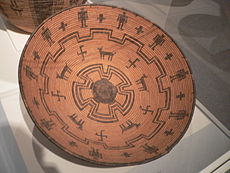
Back يافاباي Arabic Явапай Byelorussian Явапай Bulgarian Yavapais Catalan Yavapai German Yavapai Spanish Yavapais French Iavapaigh Irish Pobo yavapai Galician Yavapai Indijanci Croatian
 An early 20th-century Yavapai basket bowl woven of willow and reed | |
| Total population | |
|---|---|
| 1,551 (1992) | |
| Regions with significant populations | |
| Languages | |
| Yavapai (three dialects of Upland Yuman language), English | |
| Religion | |
| Indigenous, Christianity | |
| Related ethnic groups | |
| Havasupai, Hualapai, Mohave, Western Apache |
The Yavapai (/ˈjævəˌpaɪˌ/ YAV-ə-PY) are a Native American tribe in Arizona. Historically, the Yavapai – literally “people of the sun” (from Enyaava “sun” + Paay “people”)[1] – were divided into four geographical bands who identified as separate, independent peoples: the Ɖulv G’paaya, or Western Yavapai; the Yaavpe', or Northwestern Yavapai; the Gwev G’paaya, or Southeastern Yavapai; and the Wiipukpaa, or Northeastern Yavapai – Verde Valley Yavapai.
Another Yavapai band, which no longer exists, was the Mađqwarrpaa or "Desert People." Its people are believed to have mixed with the Mojave and Quechan peoples. The Yavapai have much in common with their linguistic relatives to the north, the Havasupai and the Hualapai.[2] Often the Yavapai were mistaken as Apache by American settlers, who referred to them as "Mohave-Apache," "Yuma-Apache," or "Tonto-Apache".[3]
Before the 1860s, when settlers began exploring for gold in the area, the Yavapai occupied an area of approximately 20,000 mi² (51800 km²) bordering the San Francisco Peaks to the north, the Pinaleno Mountains and Mazatzal Mountains to the southeast, and the Colorado River to the west, and almost to the Gila River and the Salt River to the south.[4]
- ^ Hodge, Frederick Webb (1968). Handbook of American Indians North of Mexico. Scholarly Press. p. 994.
- ^ Gifford, p. 249
- ^ Utley, p. 255
- ^ Salzmann, p. 58
© MMXXIII Rich X Search. We shall prevail. All rights reserved. Rich X Search